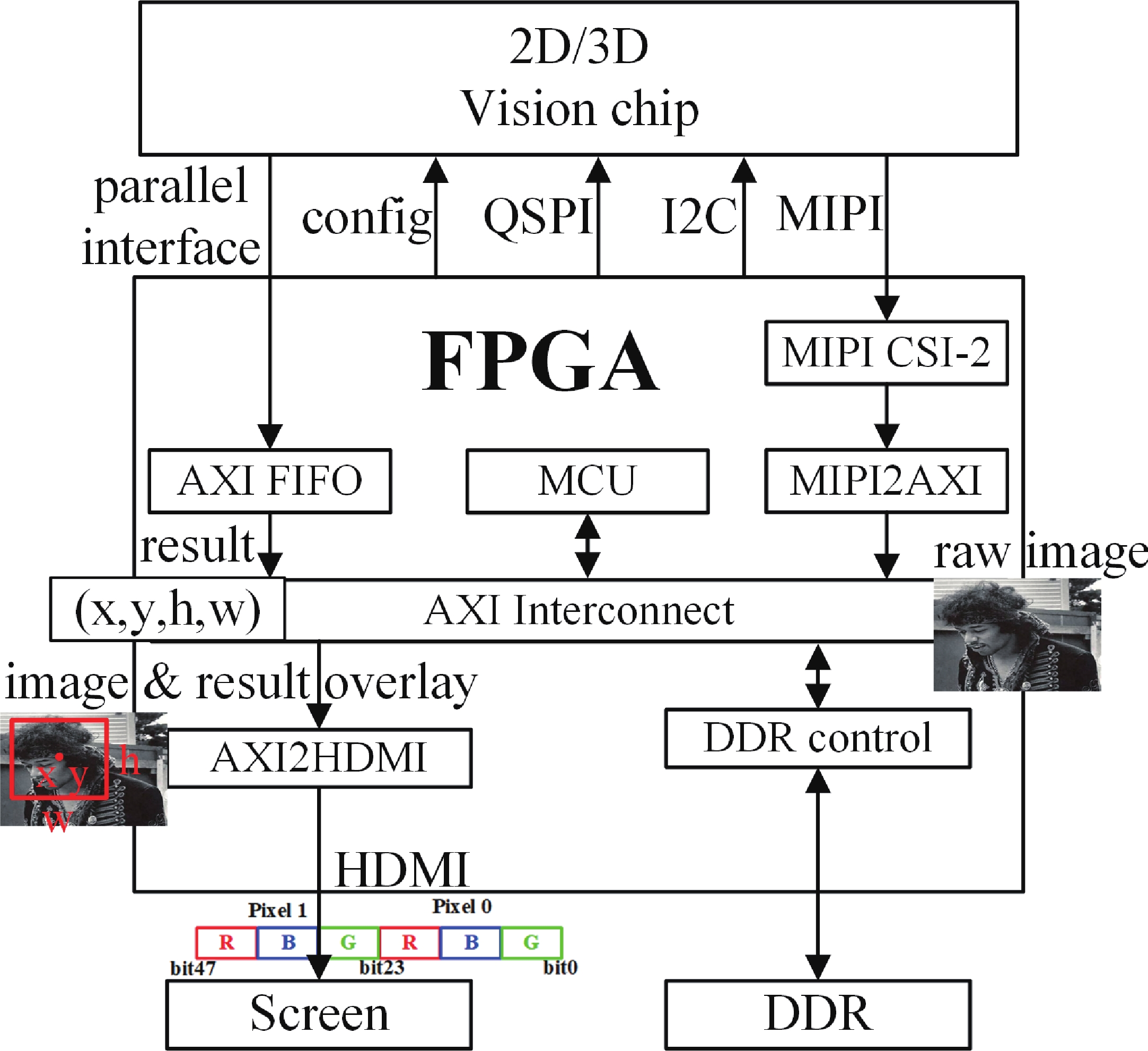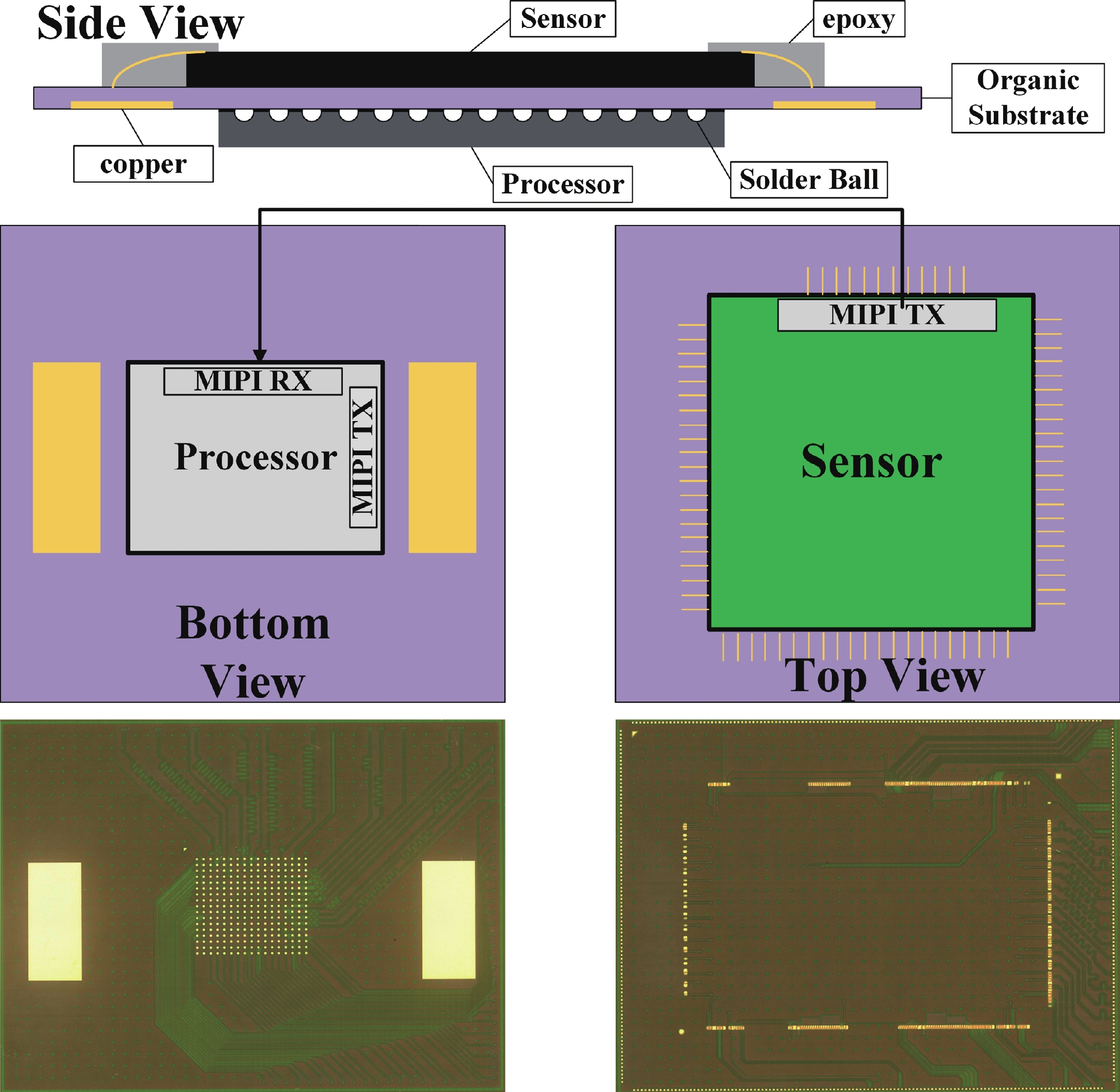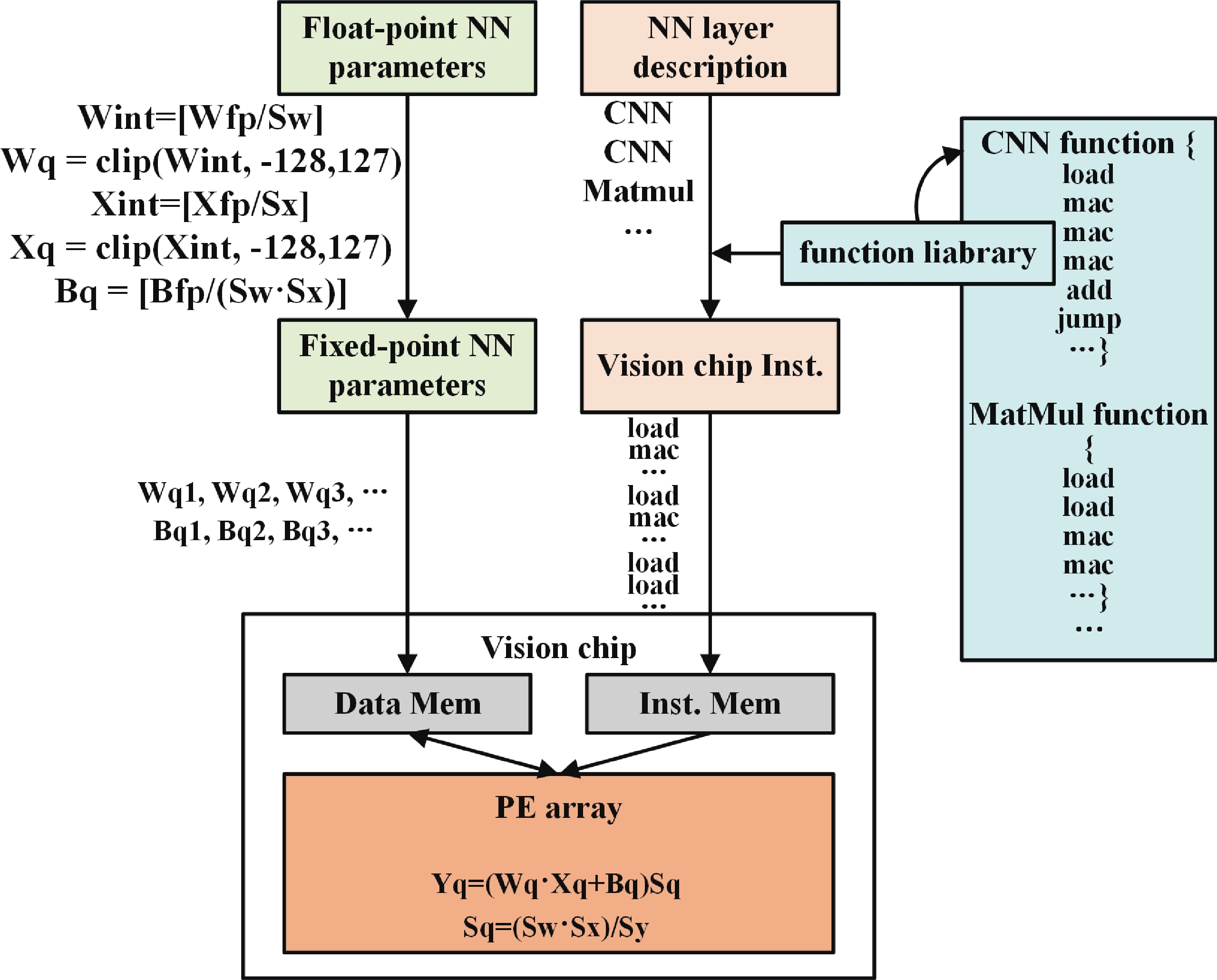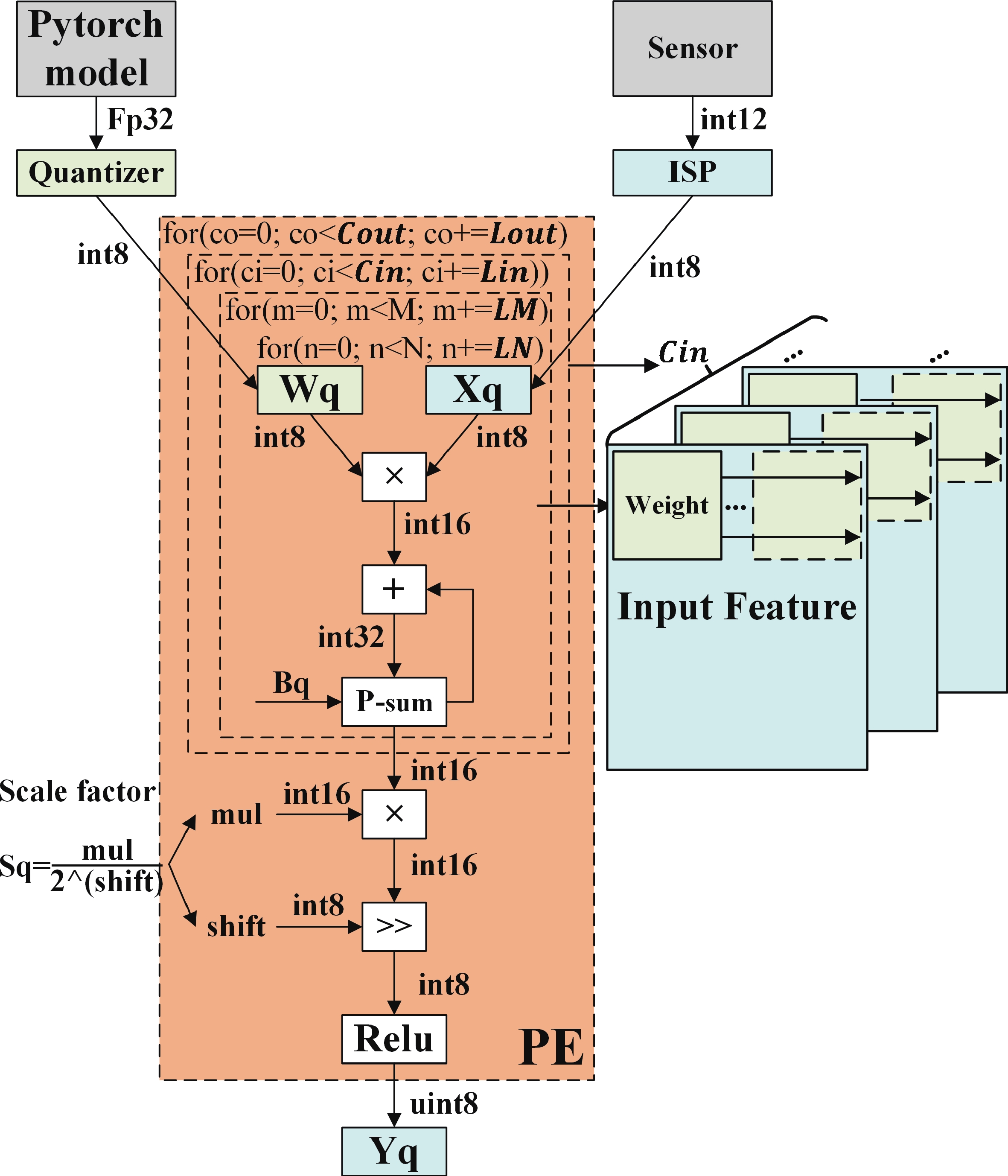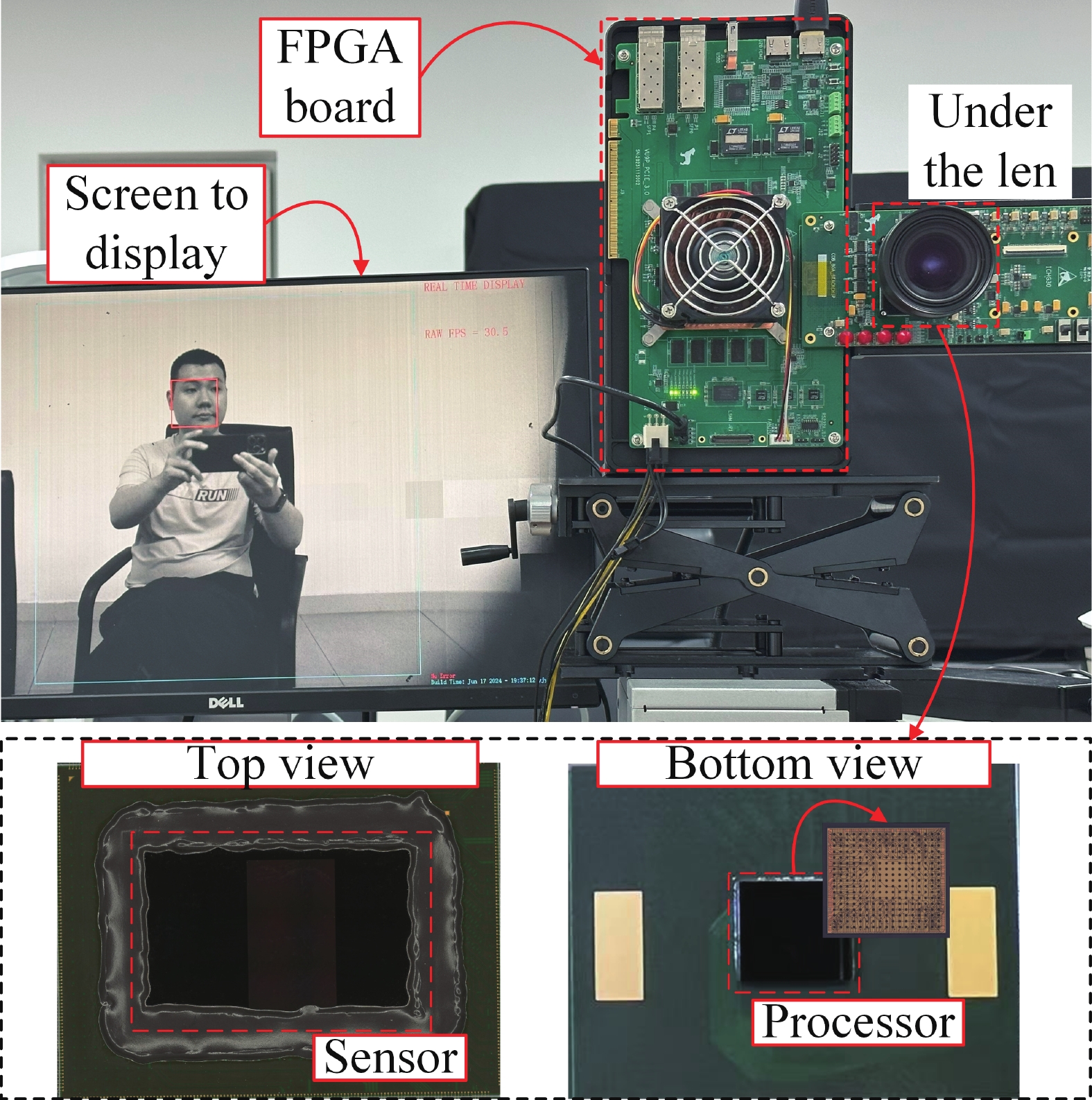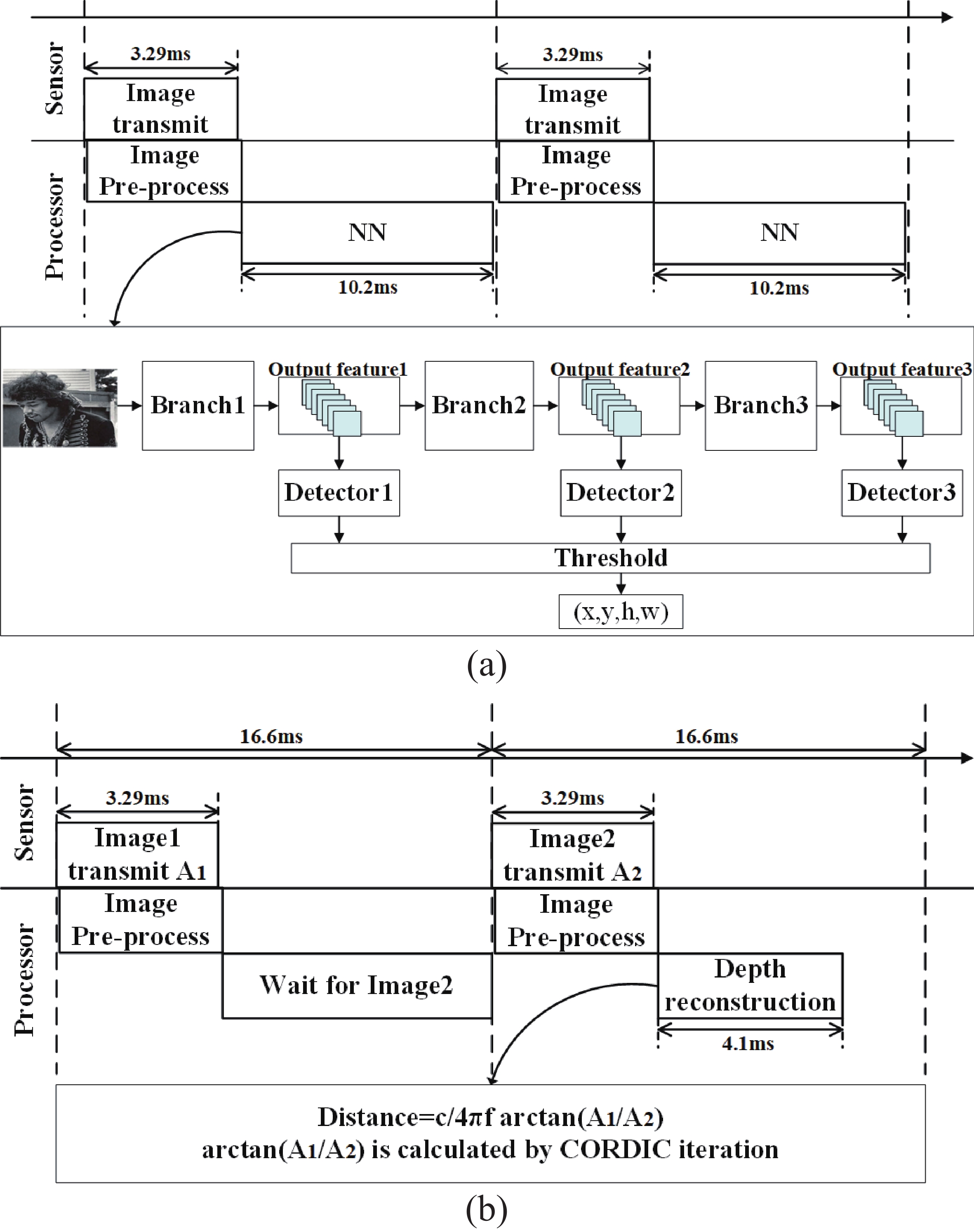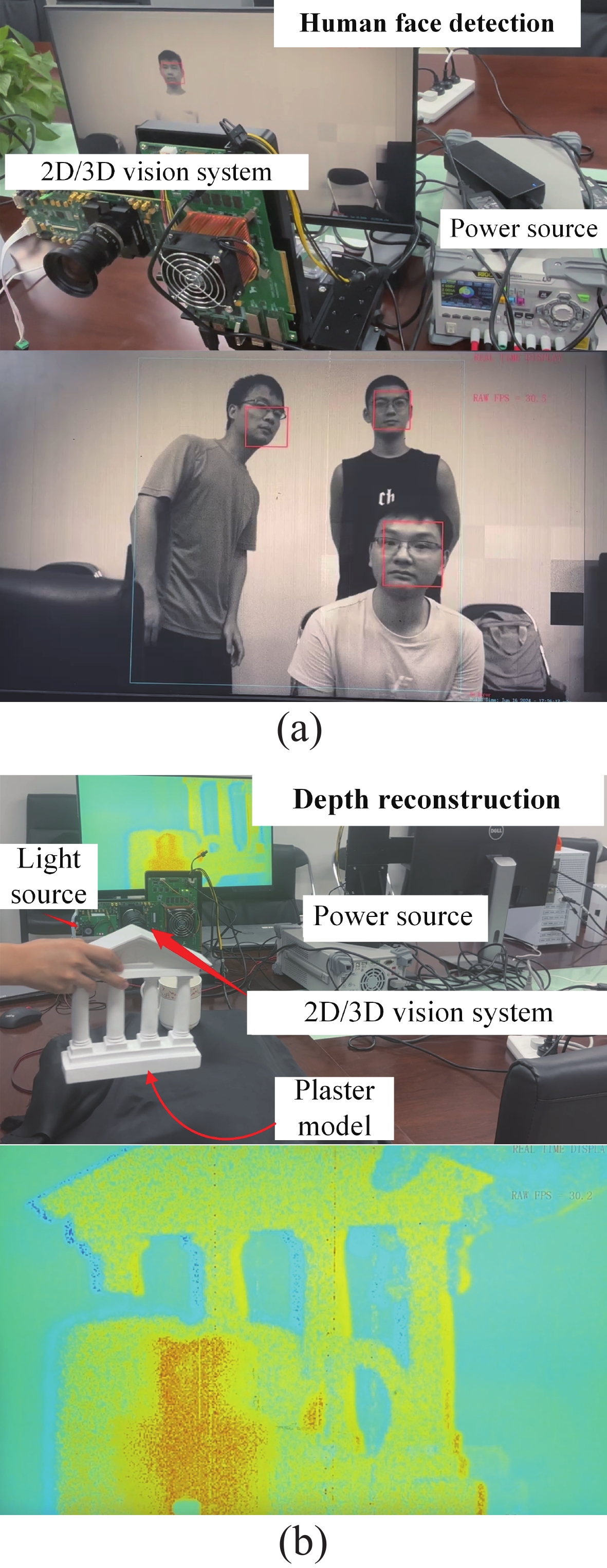| Citation: |
Siyuan Wei, Quanmin Chen, Jingyi Yu, Xuanzhe Xu, Yuxiao Wen, Runjiang Dou, Shuangming Yu, Guike Li, Kaiming Nie, Jie Cheng, Jiangtao Xu, Liyuan Liu, Nanjian Wu. A 2D/3D vision chip based on organic substrate 3D package[J]. Journal of Semiconductors, 2025, 46(10): 102201. doi: 10.1088/1674-4926/25010030
****
S Y Wei, Q M Chen, J Y Yu, X Z Xu, Y X Wen, R J Dou, S M Yu, G K Li, K M Nie, J Cheng, J T Xu, L Y Liu, and N J Wu, A 2D/3D vision chip based on organic substrate 3D package[J]. J. Semicond., 2025, 46(10), 102201 doi: 10.1088/1674-4926/25010030
|
A 2D/3D vision chip based on organic substrate 3D package
DOI: 10.1088/1674-4926/25010030
CSTR: 32376.14.1674-4926.25010030
More Information-
Abstract
This paper describes a 2D/3D vision chip with integrated sensing and processing capabilities. The 2D/3D vision chip architecture includes a 2D/3D image sensor and a programmable visual processor. In this architecture, we design a novel on-chip processing flow with die-to-die image transmission and low-latency fixed-point image processing. The vision chip achieves real-time end-to-end processing of convolutional neural networks (CNNs) and conventional image processing algorithms. Furthermore, an end-to-end 2D/3D vision system is built to exhibit the capacity of the vision chip. The vision system achieves real-timing applications under 2D and 3D scenes, such as human face detection (processing delay 10.2 ms) and depth map reconstruction (processing delay 4.1 ms). The frame rate of image acquisition, image process, and result display is larger than 30 fps. -
References
[1] Ishikawa M, Ogawa K, Komuro T, et al. A CMOS vision chip with SIMD processing element array for 1 ms image processing. 1999 IEEE International Solid-State Circuits Conference. Digest of Technical Papers (ISSCC), 1999, 206 doi: 10.1109/ISSCC.1999.759195[2] Yamazaki T, Katayama H, Uehara S, et al. A 1ms high-speed vision chip with 3D-stacked 140 GOPS column-parallel PEs for spatio-temporal image processing. 2017 IEEE International Solid-State Circuits Conference (ISSCC), 2017, 82 doi: 10.1109/ISSCC.2017.7870271[3] Kumagai O, Ohmachi J, Matsumura M, et al. A 189 × 600 back-illuminated stacked SPAD direct time-of-flight depth sensor for automotive LiDAR systems. 2021 IEEE International Solid-State Circuits Conference (ISSCC), 2021, 110 doi: 10.1109/ISSCC42613.2021.9365961[4] Withanage K I, Lee I, Brinkworth R, et al. Fall recovery subactivity recognition with RGB-D cameras. IEEE Trans Ind Inform, 2016, 12(6), 2312 doi: 10.1109/TII.2016.2590339[5] Kim G, Lee K, Kim Y, et al. A 1.22 TOPS and 1.52 mW/MHz augmented reality multicore processor with neural network NoC for HMD applications. IEEE J Solid State Circuits, 2015, 50(1), 113 doi: 10.1109/JSSC.2014.2352303[6] Lau J H. Recent advances and trends in advanced packaging. IEEE Trans Compon Packag Manuf Technol, 2022, 12(2), 228 doi: 10.1109/TCPMT.2022.3144461[7] Sharda J, Manley M, Kaul A, et al. Design and thermal analysis of 2.5D and 3-D integrated system of a CMOS image sensor and a sparsity-aware accelerator for autonomous driving. IEEE J Electron Devices Soc, 2024, 12, 426 doi: 10.1109/JEDS.2024.3354621[8] Chen Q M, Nie K M, Gao J, et al. A 1920 × 1080 array 2-D/3-D image sensor with 3-μs row-time single-slope ADC and 100-MHz demodulated PPD locked-In pixel. IEEE J Solid State Circuits, 2025, 60(6), 1 doi: 10.1109/JSSC.2024.3487196[9] Wei S Y, Ning K, Kang L, et al. A real-time 2D/3D perception visual vector processor for 1920 × 1080 high-resolution high-speed intelligent vision chips. IEEE Trans Circuits Syst I Regul Pap, 2024, 71(2), 740 doi: 10.1109/TCSI.2023.3339784[10] Xu M M, Zhao M X, Yu S M, et al. Rounding shift channel post-training quantization using layer search. 2021 4th International Conference on Artificial Intelligence and Big Data (ICAIBD), 2021, 545 doi: 10.1109/ICAIBD51990.2021.9459105[11] Zhao M X, Peng J B, Yu S M, et al. Exploring structural sparsity in CNN via selective penalty. IEEE Trans Circuits Syst Video Technol, 2022, 32(3), 1658 doi: 10.1109/TCSVT.2021.3071532[12] Zheng X M, Zhao M X, Luo Q, et al. A chip-level verification method for programmable vision chip based on deep learning algorithms. 2020 IEEE 5th International Conference on Integrated Circuits and Microsystems (ICICM), 2020, 281 doi: 10.1109/ICICM50929.2020.9292281[13] Kim D, Lee S, Park D, et al. Indirect time-of-flight CMOS image sensor with on-chip background light cancelling and pseudo-four-tap/two-tap hybrid imaging for motion artifact suppression. IEEE J Solid State Circuits, 2020, 55(11), 2849 doi: 10.1109/JSSC.2020.3021246[14] Eki R, Yamada S, Ozawa H, et al. A 1/2.3 inch 12.3 Mpixel with on-chip 4.97 TOPS/W CNN processor back-illuminated stacked CMOS image sensor. 2021 IEEE International Solid- State Circuits Conference (ISSCC), 2021, 154 doi: 10.1109/ISSCC42613.2021.9365965[15] Lepecq M, Dalgaty T, Fabre W, et al. End-to-end implementation of a convolutional neural network on a 3D-integrated image sensor with macropixel array. Sensors, 2023, 23(4), 1909 doi: 10.3390/s23041909[16] Sharda J, Li W T, Wu Q C, et al. Temporal frame filtering for autonomous driving using 3D-stacked global shutter CIS with IWO buffer memory and near-pixel compute. IEEE Trans Circuits Syst I Regul Pap, 2023, 70(5), 2074 doi: 10.1109/TCSI.2023.3252486 -
Proportional views





 Siyuan Wei is currently pursuing a Ph.D. degree with the State Key Laboratory of Semiconductor Physics and Chip Technologies, Institute of Semiconductors, Chinese Academy of Sciences. His research interests include vision chips and hardware/software co-design.
Siyuan Wei is currently pursuing a Ph.D. degree with the State Key Laboratory of Semiconductor Physics and Chip Technologies, Institute of Semiconductors, Chinese Academy of Sciences. His research interests include vision chips and hardware/software co-design. Quanmin Chen received the Ph.D. degree in microelectronics and solid electronics, Tianjin University, 2024. He is currently holding a post-doctoral position at Tianjin University. His current research interests focus on low-noise pixels and analog circuit design in time-of-flight range sensors.
Quanmin Chen received the Ph.D. degree in microelectronics and solid electronics, Tianjin University, 2024. He is currently holding a post-doctoral position at Tianjin University. His current research interests focus on low-noise pixels and analog circuit design in time-of-flight range sensors. Jingyi Yu is currently pursuing the Ph.D. degree at the School of Microelectronics, Tianjin University, and at the State Key Laboratory of Semiconductor Physics and Chip Technologies, Institute of Semiconductors, Chinese Academy of Sciences. His research interests include CV algorithm design and implementation.
Jingyi Yu is currently pursuing the Ph.D. degree at the School of Microelectronics, Tianjin University, and at the State Key Laboratory of Semiconductor Physics and Chip Technologies, Institute of Semiconductors, Chinese Academy of Sciences. His research interests include CV algorithm design and implementation.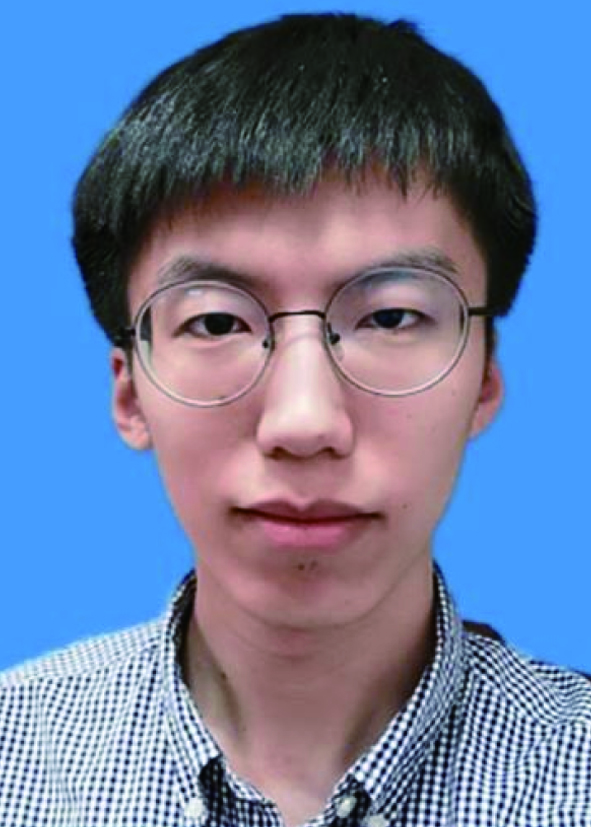 Xuanzhe Xu is currently pursuing a Ph.D. degree with the State Key Laboratory of Semiconductor Physics and Chip Technologies, Institute of Semiconductors, Chinese Academy of Sciences. His research interests include vision chips, radar signal processing, and microprocessors.
Xuanzhe Xu is currently pursuing a Ph.D. degree with the State Key Laboratory of Semiconductor Physics and Chip Technologies, Institute of Semiconductors, Chinese Academy of Sciences. His research interests include vision chips, radar signal processing, and microprocessors.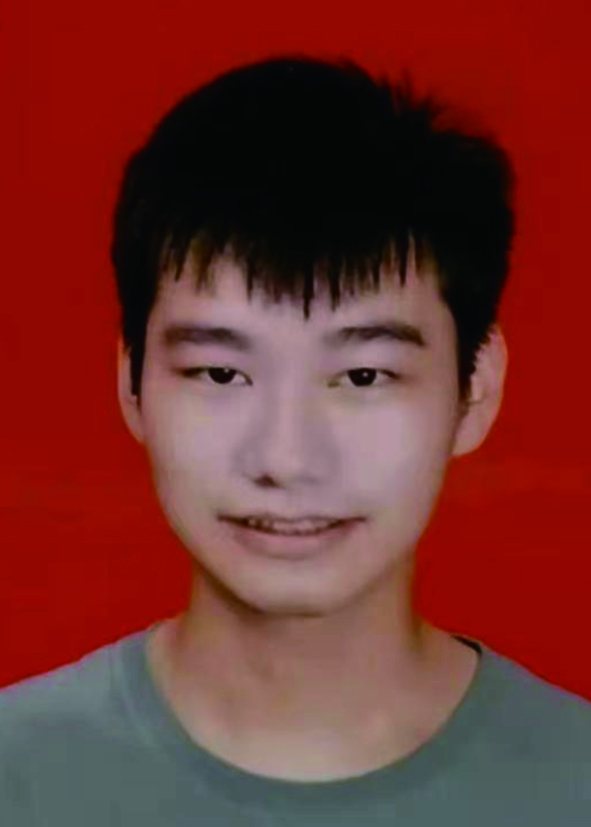 Yuxiao Wen is currently pursuing a Ph.D. degree with the State Key Laboratory of Semiconductor Physics and Chip Technologies, Institute of Semiconductors, Chinese Academy of Sciences.
Yuxiao Wen is currently pursuing a Ph.D. degree with the State Key Laboratory of Semiconductor Physics and Chip Technologies, Institute of Semiconductors, Chinese Academy of Sciences. Runjiang Dou is a Senior Engineer at the Institute of Semiconductors, Chinese Academy of Sciences. His research interests include the design of vision systems based on intelligent hardware.
Runjiang Dou is a Senior Engineer at the Institute of Semiconductors, Chinese Academy of Sciences. His research interests include the design of vision systems based on intelligent hardware. Shuangming Yu is an Associate Professor with the State Key Laboratory of Semiconductor Physics and Chip Technologies, Institute of Semiconductors, CAS. His current research interests include vision chip design and ultra-low power circuit design.
Shuangming Yu is an Associate Professor with the State Key Laboratory of Semiconductor Physics and Chip Technologies, Institute of Semiconductors, CAS. His current research interests include vision chip design and ultra-low power circuit design.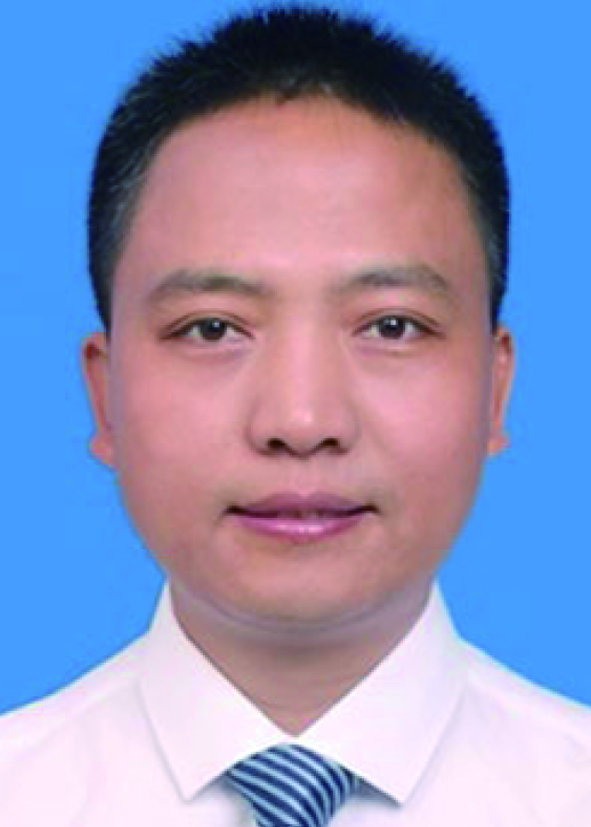 Guike Li has been an Assistant Professor of microelectronics and solid-state electronics with the State Key Laboratory of Semiconductor Physics and Chip Technologies, Institute of Semiconductors, Chinese Academy of Sciences. His current research interests include CMOS image sensors and integrated silicon photonics.
Guike Li has been an Assistant Professor of microelectronics and solid-state electronics with the State Key Laboratory of Semiconductor Physics and Chip Technologies, Institute of Semiconductors, Chinese Academy of Sciences. His current research interests include CMOS image sensors and integrated silicon photonics. Kaiming Nie has been a Professor with the School of Microelectronics, Tianjin University. His research interests include mixed analog/digital circuit design and CMOS image sensor design.
Kaiming Nie has been a Professor with the School of Microelectronics, Tianjin University. His research interests include mixed analog/digital circuit design and CMOS image sensor design. Jie Cheng has been the deputy manager of SuperPix Micro Technology Co., Ltd. He is a professor-level senior engineer responsible for the digital circuit design of the company.
Jie Cheng has been the deputy manager of SuperPix Micro Technology Co., Ltd. He is a professor-level senior engineer responsible for the digital circuit design of the company. Jiangtao Xu has been a Professor with the School of Microelectronics, Tianjin University. His research interests include CMOS image sensors and camera systems.
Jiangtao Xu has been a Professor with the School of Microelectronics, Tianjin University. His research interests include CMOS image sensors and camera systems. Liyuan Liu joined the State Key Laboratory of Semiconductor Physics and Chip Technologies, Institute of Semiconductors, Chinese Academy of Sciences, Beijing, as an Associate Professor in 2012, where he became a professor in 2018. His research interests include mixed-signal IC design, CMOS image sensors design, terahertz image sensors design, and monolithic vision chip design.
Liyuan Liu joined the State Key Laboratory of Semiconductor Physics and Chip Technologies, Institute of Semiconductors, Chinese Academy of Sciences, Beijing, as an Associate Professor in 2012, where he became a professor in 2018. His research interests include mixed-signal IC design, CMOS image sensors design, terahertz image sensors design, and monolithic vision chip design.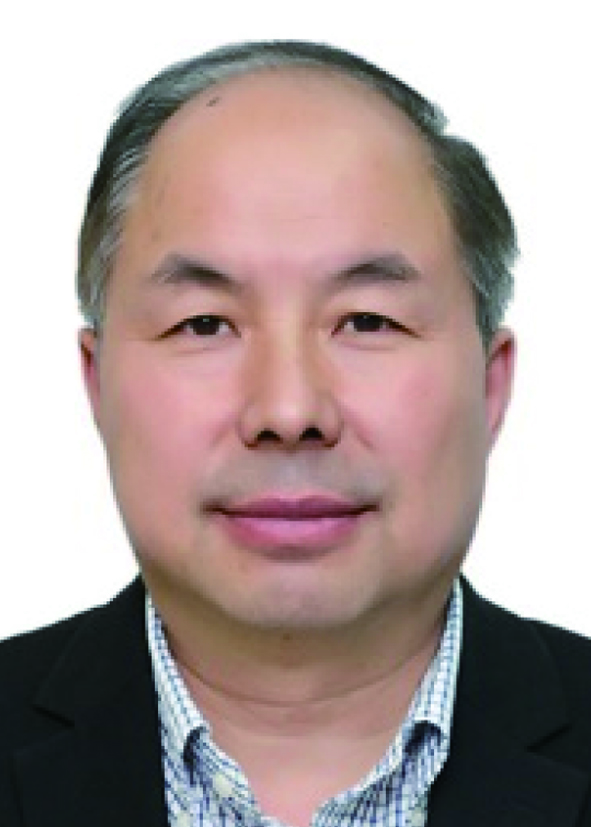 Nanjian Wu has been a Professor with the State Key Laboratory of Semiconductor Physics and Chip Technologies, Institute of Semiconductors, Chinese Academy of Sciences, Beijing, China, since 2000. His research includes the field of mixed-signal VLSI and vision chip design.
Nanjian Wu has been a Professor with the State Key Laboratory of Semiconductor Physics and Chip Technologies, Institute of Semiconductors, Chinese Academy of Sciences, Beijing, China, since 2000. His research includes the field of mixed-signal VLSI and vision chip design.
 DownLoad:
DownLoad:
